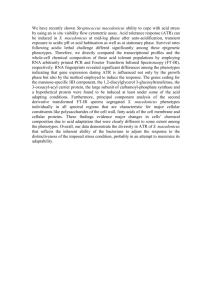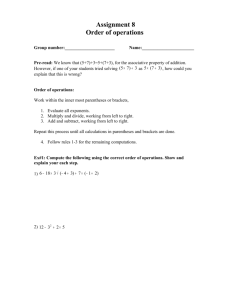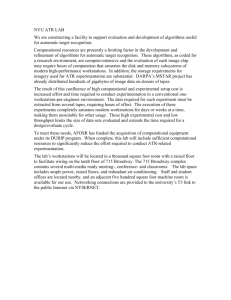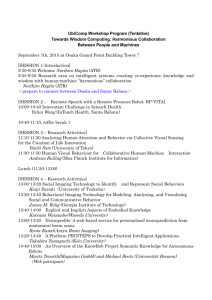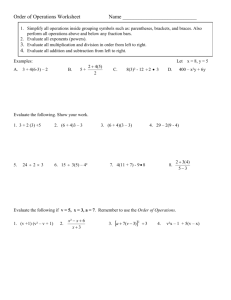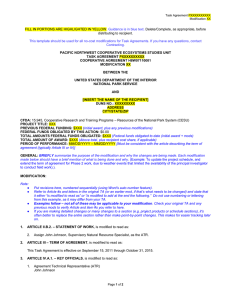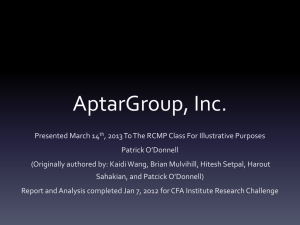10_Distribution Function_Overhead Slides
advertisement
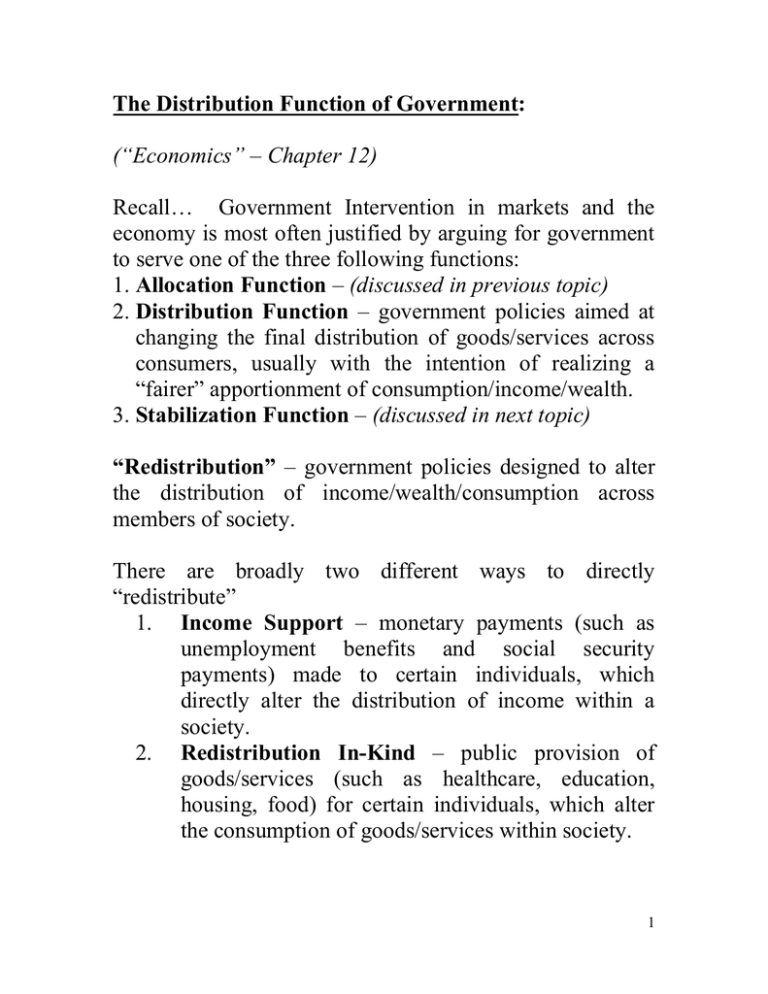
The Distribution Function of Government: (“Economics” – Chapter 12) Recall… Government Intervention in markets and the economy is most often justified by arguing for government to serve one of the three following functions: 1. Allocation Function – (discussed in previous topic) 2. Distribution Function – government policies aimed at changing the final distribution of goods/services across consumers, usually with the intention of realizing a “fairer” apportionment of consumption/income/wealth. 3. Stabilization Function – (discussed in next topic) “Redistribution” – government policies designed to alter the distribution of income/wealth/consumption across members of society. There are broadly two different ways to directly “redistribute” 1. Income Support – monetary payments (such as unemployment benefits and social security payments) made to certain individuals, which directly alter the distribution of income within a society. 2. Redistribution In-Kind – public provision of goods/services (such as healthcare, education, housing, food) for certain individuals, which alter the consumption of goods/services within society. 1 Any such policies are based upon the premise that the distribution of income/consumption that results from the free market system is not best. But, “what distribution of income is best or most desirable?” Is a “more even distribution of income” necessarily an “ideal” for which we should strive? What determines income and wealth (and therefore consumption) in a free market system? 7 Determinants of Productivity, Income, and Wealth: 1. Natural Talent and Ability – ability is not distributed equally at birth; some people possess attributes (e.g., intelligence, strength) that make them more productive 2. Acquired Skills – individual productivity depends in large part upon skills and experiences acquired during education, training, and work experience 3. Effort – productivity is often largely dependent upon effort (“workers” are more productive than “shirkers”) 4. Compensating Differentials – differences in wages that results from differences in working conditions (e.g., risky jobs pay more; “glamour jobs” pay less) 5. Inherited Wealth – wealth is distributed less evenly than income (due partly to differences in inheritances) 6. Accumulated Savings – the stock of wealth that a person has at any point in time is partly determined by previous consumption/savings decisions 7. Seemingly Unrelated Market Conditions – income depends in part upon economic conditions beyond our control; a worker’s value depends greatly upon the price of the product he helps produce (e.g., wage of a coal miner would increase if we ran out of oil) 2 How is income distributed in the U.S.? United States 1980 Real Per Capita GDP $25,640 % of Income earned 17.68% by Bottom 50% % of Income earned 43.30% by Bottom 75% % of Income earned 67.87% by Bottom 90% % of Income earned 91.54% by Bottom 99% 1989 $31,877 1998 $37,238 2007 $43,926 14.96% 13.67% 12.26% 37.72% 34.37% 31.29% 61.00% 56.23% 51.95% 85.81% 81.53% 77.17% Can we graphically illustrate the distribution of income across members of society? Can we develop a single numerical measure of income inequality? Lorenz Curve – a graph illustrating the cumulative amount of income earned by each cumulative portion of the population “More even” distribution of income Lorenz Curve “closer to 45-degree line” Gini-Coefficient – a quantitative measure of income inequality based upon the Lorenz Curve, defined as the ratio of “the area between 45-degree line and the Lorenz Curve” to “the entire area below 45-degree line.” 3 Lorenz Curve and Gini-Coefficient: “ 45 0 – Line” or “Line of Perfect Income Equality” Fraction of Total Income 1 .7717 .5195 .3129 Lorenz Curve for U.S. (2007) .1226 Fraction of Total Population 0 0 .50 .75 .90 .99 1 Green (Gini-Coefficient) = Green Blue Fraction of Total Income 1 “ 45 0 – Line” or “Line of Perfect Income Equality” Lorenz Curve for U.S. (2007) 0 0 1 Fraction of Total Population 4 Extreme Equality => Lorenz Curve on 45-degree line => Gini-Coefficient equal to zero: G 0 0 0 Fraction of Total Income 1 1 2 Fraction of Total Population 0 1 0 Extreme Inequality (one person having all income) => Lorenz Curve lies along horizontal axis => GiniCoefficient equal to one: G 1 1 2 1 2 Fraction of Total Income 0 1 Fraction of Total Population 0 1 0 United States Gini Coefficient 1980 .403 1989 .431 1998 .456 2007 .463 The distribution of incomes in the U.S. has become “less equal” over the past three decades 5 Question: Even if you “value income equality,” should you “always prefer a smaller value of the Gini-Coefficient”? Recognize that the Gini-Coefficient tells us nothing about “income levels,” but rather only describes “how an amount of income is divided” Real Per Capita GDP increased from 1980 to 2007 United States Gini Coefficient Real Per Capita GDP 1980 .403 $25,640 1989 .431 $31,877 1998 .456 $37,238 2007 .463 $43,926 Further, over these years, Real Household Income (i.e., adjusted for inflation) increased for every segment of the population => Table below reports the “income cutoff level” (in real terms, that is adjusted for inflation) for each stated percentile in each year. Real Household Income 20th Percentile 40th Percentile 60th Percentile 80th Percentile 95th Percentile 1980 $24,916 $41,950 $59,415 $83,372 $131,766 1989 $25,837 $45,207 $65,873 $96,145 $159,779 1998 $27,439 $47,882 $71,164 $106,318 $184,452 2007 $27,864 $49,510 $75,000 $112,638 $197,216 Over the past three decades in the U.S. “Rich” have become “richer” => 35.1% increase ($83,372 to $112,638) in “cutoff of 80th Percentile” “Middle class” has become “richer” => 18% increase ($41,950 to $49,510) in “cutoff of 40th Percentile” “Poor” have become “richer” => 11.8% increase ($24,916 to $27,864) in “cutoff of 20th Percentile” Of these four years, which realization of incomes is most desirable? To me, the obvious answer is 2007 (even though it has the highest valued Gini Coefficient) 6 Comparison of Income Inequality across countries: in general there is a trend for “societies with higher levels of per person income to have a more even distribution of income” (or equivalently, for “societies with lower levels of per person income to have a less even distribution of income”). Notable exceptions: U.S., Hong Kong, Singapore (economies closer to the “free market” side of the spectrum) Country: Norway Singapore United States Canada Sweden United Kingdom France New Zealand Russia Mexico South Africa Brazil Turkey Colombia India Zimbabwe Per Capita GDP (PPP): $55,600 $48,900 $46,000 $38,200 $36,900 $35,300 $33,800 $26,000 $14,600 $12,500 $10,300 $10,100 $9,400 $7,200 $2,700 $500 Gini Coefficient: 0.28 0.52 0.45 0.32 0.23 0.34 0.28 0.36 0.41 0.51 0.65 0.57 0.44 0.54 0.37 0.50 Again, even if you desire “income equality” recall that the Gini Coefficient tells us nothing about income levels => would you pick “India’s incomes” ( G 0.37 ; Per Capita GDP of $2,700) over the “U.S.’s incomes” ( G 0.45 ; Per Capita GDP of $46,000)? 7 4 Arguments in Favor of Coercive Redistribution: 1. Utilitarian Justice – total social welfare can be increased by transferring income/wealth from the rich to the poor, so long as the marginal utility of income/wealth is diminishing. idea that society should strive for the “greatest happiness for the greatest number of people” (i.e., attempt to maximize the summation of “utility” or “happiness” over all members of society) arguments first put forth by Jeremy Bentham (17481835) and John Stuart Mill (1806-1873) if the value of $1 is greater if you have less money (i.e., diminishing marginal utility), then social welfare can be increased by taking $1 away from Ted Turner and giving it to a homeless person Jeremy Bentham's Auto-Icon at University College London 8 2. Rawlsian Justice (Social Contract Theory) – the socially best income distribution is the one which maximizes the well-being of the worst-off member of society developed by the philosopher John Rawls in A Theory of Justice (1971) consider the “ideal society” that would be designed by someone in the “beforelife” behind a “veil of ignorance” (i.e., not knowing what their realized lot in life would be, but just knowing that it would be a random draw in this “ideal society”) Rawls argues that such a person would be particularly concerned about the situation of the poorest person (i.e., the worst possible outcome) Therefore, he argues that this objectively ideal society should implement policies to apply the “maximin criterion” Maximin Criterion – a claim that the government should aim to maximize the well-being of the worst off person in society 9 3. Labor Theory of Value – the theory that the value of a commodity depends upon the amount of labor used to produce it based upon the ideas of Karl Marx (1818-1883) mainstream economists do not agree with this outdated notion => rather, the value of an item clearly depends upon benefits to consumers e.g., if Ann spends 4 hours per day growing corn and Bob spends 8 hours per day digging and then filling ditches, is Bob’s output twice as valuable recognize that Marx’s notion attributes no value to the capital (and other “non-labor inputs”) necessary for the production process since a capitalist system provides returns for all inputs (i.e., not only labor, but also capital and land), labor is vastly underpaid relative to what Marx believed was “fair” thus, in the interest of fairness, income/wealth must be redistributed away from the owners of capital and toward workers 4. Overcoming the Free-Rider Problem suppose society prefers a more equal distribution of income/wealth than what the market gives if we rely upon private charity to reduce inequality, there is a free rider problem (recall the discussion from market provision of public goods) thus, private charity does not provide enough redistribution => have government redistribute, to get an amount closer to the socially best level 10 Redistribution Programs and Policies in the U.S.: Social Security System – a system of Federal Government social insurance programs consisting of 1. Old Age and Survivors Insurance – pays cash benefits to retired workers, their survivors, and their dependents 2. Disability Insurance – pays cash benefits to disabled workers and their dependents 3. Medicare – program which provides medical insurance to people who are over age 65 or disabled Temporary Assistance for Needy Families – a welfare program that provides cash benefits to low income households Supplemental Security Income – a welfare program which provides cash benefits to poor elderly people with very low entitlements under traditional Social Security Unemployment Compensation – a state government program that pays cash benefits to laid-off workers Medicaid – a welfare program which provides medical care for people with low incomes Food Stamps – vouchers (with a face value greater than their cost) available to low income families which can be used to purchase food at grocery stores Public Housing – federal government program that provides access to housing with rents capped at 30% of income (e.g., no income => no rent) Earned Income Tax Credit – a refundable Federal Income Tax Credit available to low income families with children (i.e., some people who pay no income taxes end up getting a check back from the IRS) 11 Redistribution via Taxation: Why impose taxes? Three primary reasons for imposing taxes: 1. generate revenue for the government (in the U.S., over 90% of Federal Government revenue comes from Income and Payroll Taxes; over 60% of State Government revenue comes from income, advalorem, or social insurance taxes) 2. discourage certain behaviors, by altering the cost or benefit of engaging in the activity (e.g., try to discourage cigarette smoking by imposing per unit taxes on each pack: $1.01 per pack Federal tax plus state and perhaps local taxes => $6.86 per pack in NYC => price of over $11 per pack in NYC) 3. redistribute income (in the U.S., we engage in a great deal of redistribution indirectly, by imposing higher income tax rates on the rich than on the poor => “progressive taxation”) Would everyone agree: regardless of how much tax revenue we want to raise, we should do so with a tax system that is “fair”? What exactly do we mean by “fair”? Two notions of “fairness” 1. Horizontal Equity – two individuals of equal economic capacity should have equal tax burdens 2. Vertical Equity – individuals of greater economic capacity should not have a smaller tax burden 12 What exactly do we mean by “tax burden”? Common to describe a “tax structure” as Progressive, Proportional, or Regressive, by examining how the “Average Tax Rate” behaves as income is increased. Average Tax Rate (ATR) –the amount of total taxes paid divided by income. i. Progressive Tax – tax structure for which ATR increases as the level of income is increased. ii. Proportional Tax – tax structure for which ATR remains constant as the level of income is increased. iii. Regressive Tax – tax structure for which ATR decreases as the level of income is increased. Marginal Tax Rate (MTR) –the percentage of the next dollar earned that must be paid in taxes. As a general rule (i.e., mathematical implication): 1. ATR will increase whenever MTR ATR 2. ATR will decrease whenever MTR ATR Examples: i. Progressive: U.S. Federal Income Tax ii. Proportional: “flat tax” with no deductions whatsoever (e.g., “flat tax” proposed by Steve Forbes in 1996 was NOT a proportional tax, since the first $33,000 of earnings were not taxed; income taxes in Albania (10%), Bulgaria (10%), Czech Republic (15%), Iraq (15%), Jamaica (25%), Hong Kong (16%), Mongolia (10%), Russia (13%), Slovakia (19%), Ukraine (15%)) iii. Regressive: Social Security Payroll Tax – first $102,000 taxed at a marginal rate of 6.2%, while additional earnings are not taxed at all 13 So, back to the question of “What exactly do we mean by ‘fair’?”… If “economic capacity” is equated to “income” and “tax burden” is equated to “average tax rate,” then: 1. Horizontal Equity => two individuals with equal incomes should have equal average tax rates 2. Vertical Equity => an argument against regressive taxes, in favor of proportional or progressive taxes However, if “tax burden” were instead equated to “total dollars paid in taxes,” then even regressive taxes can be “vertically equitable.” i.e. – even for a regressive tax, “total dollars paid in taxes” can increase as level of income increases. Is “income” the only important determinant of “economic capacity”? e.g. – consider the following two taxpayers: 1. 22 year old single college graduate earning $50,000 per year 2. 45 year old high school educated married couple with 4 kids earning a total of $50,000 per year Many of the “exemptions” and “deductions” built into our tax code are based upon recognitions that things other than income are important for determining economic capacity 14 But, “Inequities” (both “vertical” and “horizontal”) can easily result due to “deductions” and “exemptions”… Consider the following five taxpayers in 2010: AGI Taxpayer (Line 37 of 1040) Mitt R. $21,646,507 Newt G. $3,142,066 Barack O. $1,728,096 Rick S. $923,411 Joe B. $379,178 Total Taxes Paid (Line 60 from 1040) $3,009,766 $994,708 $453,770 $263,442 $86,626 ATR 13.90 31.66 26.26 28.53 22.85 If “ATR” is “tax burden” and “AGI” is “economic capacity,” then these outcomes violates the notion of “vertical equity” If instead “dollars paid in taxes is “tax burden” and “AGI” is “economic capacity,” then these outcomes do not violate the notion of “vertical equity” Should the U.S. Federal Income Tax be modified or is the current system “good”? To begin to answer this question it is important to first have an understanding of both: I. the historical evolution of the U.S. Federal Income Tax II. the distribution of “tax burden” under the current U.S. Federal Income Tax 15 U.S. Federal Income Tax 16th Amendment to the U.S. Constitution ratified on 2/3/1913 – authorized congress to levy an income tax U.S. Federal Income Tax established in 1913 Progressive Tax (increasing MTR) Primary source of U.S. Government tax receipts I. Historical Tax Rates (“married couple filing jointly”) Year: 1913 1921 1928 1932 1941 1945 1954 1964 1980 1992 2000 2002 2012 # of Brackets: 7 brackets 56 brackets 23 brackets 55 brackets 32 brackets 24 brackets 24 brackets 26 brackets 16 brackets 3 brackets 5 brackets 6 brackets 6 brackets Low MTR: 1.0% 4.0% 1.5% 4.0% 10.0% 23.0% 20.0% 16.0% 0% 15.0% 15.0% 10.0% 10.0% High MTR: 7.0% 73.0% 25.0% 63.0% 81.0% 94.0% 91.0% 77.0% 70.0% 31.0% 39.6% 35.0% 35.0% * In reality the “effective Low MTR” has always been 0%, due to the presence of exemptions and deductions… 16 II. Outcomes under current U.S. Federal Income Tax (?) How many of you agree with the following statement: “The rich don’t pay their fair share of taxes.” Let’s focus on the “Top 1% of income earners.” What percentage of “Total Income Taxes” should they pay? a. 1% b. 10% c. 20% d. 25% All of the following figures are from… http://taxfoundation.org/sites/taxfoundation.org/files/docs/ff285.pdf …and are reported for 2009 (unless otherwise indicated). 17 II.A) Disproportionate amount of tax dollars come from “The Rich” Group’s Group’s % Range Income Share of Share of of Income Split Income Taxes Income Top 1% $343,927+ 36.7% 16.9% Top 5% $154,643+ 58.7% 31.7% Top 10% $112,124+ 70.5% 43.2% Top 25% $66,193+ 87.3% 65.8% Top 50% $32,396+ 97.7% 86.5% “Top 5%” pay 58.7% of all income tax dollars “Bottom 95%” pay (100–58.7) = 41.3% “Top 10%” pay 70.5% of all income tax dollars “Bottom 90%” pay (100–70.5) = 29.5% “Top 1%” pay more income taxes than the “Bottom 90%” (36.7% versus 29.5%) “Top 1%” pay almost as much in income taxes as the “Bottom 95%” (36.7% versus 41.3%) “Top 50%” pay 97.7% of all income tax dollars “Bottom 50%” only pay (100–97.7) = 2.3% of all income tax dollars 137.98 million tax returns with “positive AGI” Of these, 59 million (or 42.76% of the filed returns) had federal income tax liability of $0 These people not only got back every single dollar the Federal government withheld, but in some cases received money back from the IRS (recall the EITC) 18 II.B) U.S. Federal Income Tax is clearly progressive % Range of Income Top 1% Top 2%-5% Top 6%-10% Top 11%-25% Top 26%-50% Bottom 50% Average Tax Rate 24.01% 16.4% 11.4% 8.25% 5.56% 1.85% Progressive since ATR is higher at higher incomes II.C) Across income levels, ATR has “evolved” over time 1980 1988 1992 2000 2008 2009 Top 1% 34.47% 24.04% 25.05% 27.45% 23.27% 24.01% Top 11-25% 14.80% 11.82% 11.39% 12.04% 9.29% 8.25% Top 26-50% 11.91% 9.60% 9.42% 9.28% 6.75% 5.56% Btm 50% 6.10% 5.06% 4.39% 4.60% 2.59% 1.85% Between 2000 and 2009: ATR of every income group decreased % decrease in ATR: o 12.53% ([27.45–24.01]/[27.45]) decrease in ATR for “Top 1%” o 31.48% decrease in ATR for “Top 11-25%” o 40.09% decrease in ATR for “Top 26-50%” o 59.78% decrease in ATR for “Bottom 50%” 19 Antipoverty Programs and Work Incentives: many policies aimed at helping the poor have the unintended effect of discouraging the poor from escaping poverty on their own therefore, “equity” or “fairness” should not be the only consideration when considering redistribution policies all redistribution policies reduce incentives for people to work, produce output, and earn income => people will work less with policies in place (“cost-benefit principle”) Disincentive effects of progressive taxation… incentives to earn additional income are reduced when the Marginal Tax Rate is higher, since the worker gets to “keep less of the next dollar earned.” experience of Ronald Reagan as an actor in Hollywood when the highest MTR was over 90%: “As an actor in Hollywood during the years when the marginal tax rate was 90 percent, Reagan had reacted with rationality: once he hit the higher tax brackets, he’d simply stop working for the rest of the year. There was no point in continuing.” (Commanding Heights, page 348) Disincentive effects of “means tested” transfers… many transfers programs are “means tested” (i.e., you only qualify if your income is below a certain threshold) as income rises, you may lose your benefits => no longer eligible for welfare, Medicaid, food stamps, EITC historically, some poor families have faced “effective marginal tax rates” (accounting for decreased benefits) of OVER 100% as they lose their benefits => actually BETTER OFF without earning the extra income! 20
